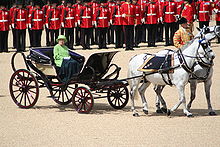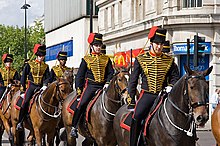Postilion




A postilion (or postillion, occasionally Anglicised to "post-boy"[1]) rider was the driver of a horse-drawn coach or post chaise, mounted on one of the drawing horses.[2] By contrast, a coachman would be mounted on the vehicle along with the passengers.
Postilion riders normally rode the left (or "near") horse of a pair because horses usually were trained only to be mounted from the left.[3][4] With a double team, either there would be two postilions, one for each pair,[5] or one postilion would ride on the left rear horse in order to control all four horses.
Postilions were typically supplied with a special rigid boot for use on their inside (right hand) leg. This appliance provided protection from possible crushing injury due to contact with the central wooden shaft (if any) and the body of the adjacent horse.
Travel by post
This style of travel was known as "posting."[6] The postilions and their horses (known as "post-horses")[7] would be hired from a "postmaster" at a "post house."[1] The carriage would travel from one post house to the next (a journey known as a "stage"), where the postilions and/or spent (exhausted) horses could be replaced if necessary.[1] In practice unless a return hire was anticipated a postilion of a spent team frequently was also responsible for returning them to the originating post house.
Posting was once common both in England and in continental Europe.[8] In addition to a carriage's obvious advantages (a degree of safety and shelter for the inside passengers and accessibility to non-riders) on long trips it tended to be the most rapid form of passenger travel. Individually mounted riders are subject to their personal endurance limits, while posting could continue indefinitely with brief stops for fresh horses and crew. In England, posting declined once railways became an alternative method of transport,[1] but it remained popular in France and other countries.
Modern examples
The gun detachments of the The King's Troop, Royal Horse Artillery, are each driven by a team of three post riders. The King's Troop is a ceremonial unit equipped with World War I veteran 13 pounder field guns drawn by six horses in much the same configuration as the guns of the 19th and early 20th century would have been. Officers and Senior Non-Commissioned Officers (NCOs) ride separately.

The United States Army's Old Guard Caisson Platoon also rides postilion, as their predecessors did in the 19th Century, carrying cannon to war. The section sergeant, on a separate horse, is in charge of the team and there are 6 other horses teamed together, used at Arlington National Cemetery.[9]

See also
- Le postillon de Lonjumeau, an 1836 French comic opera by Adolphe Adam.
- "My postillion has been struck by lightning". A comical phrase supposedly found in old-fashioned foreign language phrase books.
- Der Postillon, German satirical news site.
References
- ^ a b c d Rogers (1900), p. 280
- ^ Definition of postillion by the Free Online Dictionary, Thesaurus and Encyclopedia.
- ^ Which side of the road do they drive on? Brian Lucas.
- ^ Rogers (1900), p. 279
- ^ Rogers (1900), pp 282–283, 107
- ^ Rogers (1900), p. 278
- ^ Rogers (1900), p. 282
- ^ Rogers (1900), pp. 279–280
- ^ http://www.army.mil/info/organization/unitsandcommands/commandstructure/theoldguard/specplt/caisson.htm
Bibliography
- Rogers, Fairman (1900). A Manual of Coaching. Philadelphia: J.B. Lippincott Company. OCLC 6478019.
